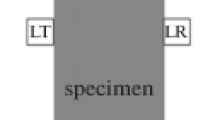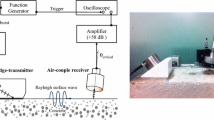Conclusions
In ultrasonic tests of concrete quality in thick-walled structures (more than 0.5 m thick) and in massive blocks in hydraulic structures, it is necessary to take into account change in the amplitude-frequency spectra of ultrasound pulses with the path length in the concrete, which is a regular phenomenon associated with the normal absorbing properties of the concrete. This must be distinguished from the changes indicating quality deterioration or structural defects in the concrete. The quantitative decrease in the velocity of propagation of ultrasound along a ray in the direction of each sounding depends on the physicomechanical properties of the concrete, its composition, its age, and the natural frequency of the ultrasound-pulse emitter-transducer; for measurement bases between 1 and 6 m, it lies in the range 1–12%. Correction coefficients δ for assessing the effect of this factor can be found with sufficient accuracy for practical purposes from the measured acoustic characteristics of the concrete, in conjunction with the theoretical relation (13) or the graphs in Fig. 6.
Similar content being viewed by others
Literature Cited
A. K. Tret'yakov and A. M. Filonidov, “Ultrasound tests of solid concrete at the Dneprodzerzhinsk hydroelectric station,” Gidrotekh. Stroitel', No. 3 (1962).
N. A. Krylov, Electronic-Acoustic and Radiometric Methods of Testing Materials and Structures [in Russian], Gosstroiizdat (1963).
S. I. Nogin, “Investigation of the quality of heavy concrete in specimens and structures by acoustic methods,” Dissertation (1965).
A. M. Filonidov, “Investigation of the propagation of ultrasound in hydraulic concrete,” Gidrotekh. Stroitel'. No. 12 (1964).
B. G. Deryagin, “On damping and dispersion of seismic waves,” Geofizika, No. 1–2 (1931).
G. I. Gurevich, “On the principal laws of propagation and damping of seismic vibrations,” in: Topics in the Dynamic Theory of Propagation of Seismic Waves [in Russian], Nos. 6 and 7, Izdanie LGU (1962–1963) [symposium].
H. Kolsky, “The propagation of acoustic pulses in linear viscoelastic solids,” Fourth International Congress on Acoustics, Vol. 1 (1962).
V.V. Sudakov, Practical Uses of Electronics in Building [in Russian], Stroiizdat (1964).
W. F. Futtermann, “Dispersive body waves,” Journal of Geophysical Research, 67, No. 13 (1962).
I. V. Zashchuk, Electronic and Acoustic Methods of Testing Building Materials [in Russian], izd-vo Vysshaya Shkola (1968).
Additional information
Translated from Gidrotekhnicheskoe Stroitel'stvo, No. 2, pp. 32–36, February, 1970.
Rights and permissions
About this article
Cite this article
Filonidov, A.M. Relation between ultrasound propagation velocity and path length in solid concrete. Hydrotechnical Construction 4, 145–151 (1970). https://doi.org/10.1007/BF02377235
Issue Date:
DOI: https://doi.org/10.1007/BF02377235




